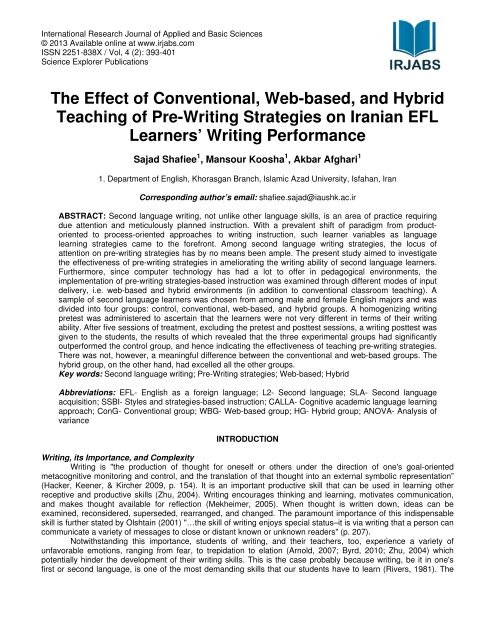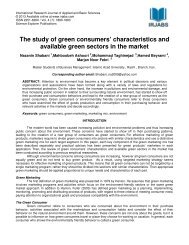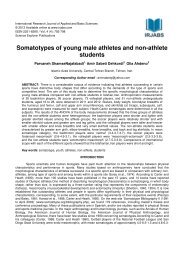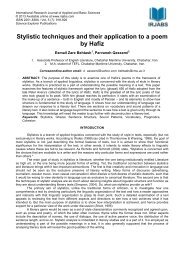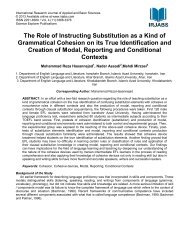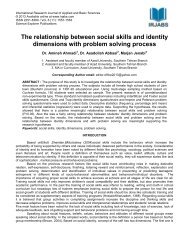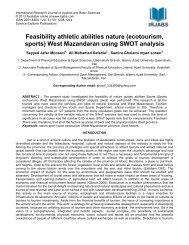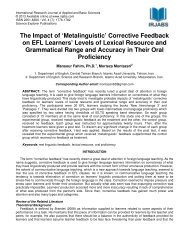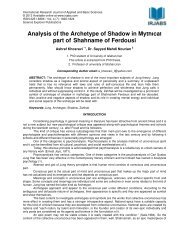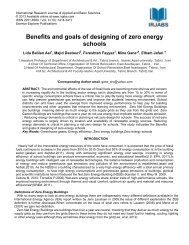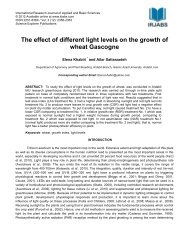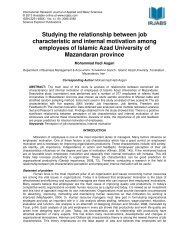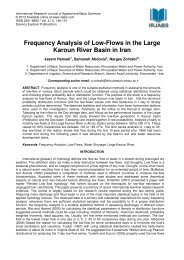The Effect of Conventional, Web-based, and Hybrid Teaching of Pre ...
The Effect of Conventional, Web-based, and Hybrid Teaching of Pre ...
The Effect of Conventional, Web-based, and Hybrid Teaching of Pre ...
Create successful ePaper yourself
Turn your PDF publications into a flip-book with our unique Google optimized e-Paper software.
International Research Journal <strong>of</strong> Applied <strong>and</strong> Basic Sciences© 2013 Available online at www.irjabs.comISSN 2251-838X / Vol, 4 (2): 393-401Science Explorer Publications<strong>The</strong> <strong>Effect</strong> <strong>of</strong> <strong>Conventional</strong>, <strong>Web</strong>-<strong>based</strong>, <strong>and</strong> <strong>Hybrid</strong><strong>Teaching</strong> <strong>of</strong> <strong>Pre</strong>-Writing Strategies on Iranian EFLLearners’ Writing PerformanceSajad Shafiee 1 , Mansour Koosha 1 , Akbar Afghari 11. Department <strong>of</strong> English, Khorasgan Branch, Islamic Azad University, Isfahan, IranCorresponding author’s email: shafiee.sajad@iaushk.ac.irABSTRACT: Second language writing, not unlike other language skills, is an area <strong>of</strong> practice requiringdue attention <strong>and</strong> meticulously planned instruction. With a prevalent shift <strong>of</strong> paradigm from productorientedto process-oriented approaches to writing instruction, such learner variables as languagelearning strategies came to the forefront. Among second language writing strategies, the locus <strong>of</strong>attention on pre-writing strategies has by no means been ample. <strong>The</strong> present study aimed to investigatethe effectiveness <strong>of</strong> pre-writing strategies in ameliorating the writing ability <strong>of</strong> second language learners.Furthermore, since computer technology has had a lot to <strong>of</strong>fer in pedagogical environments, theimplementation <strong>of</strong> pre-writing strategies-<strong>based</strong> instruction was examined through different modes <strong>of</strong> inputdelivery, i.e. web-<strong>based</strong> <strong>and</strong> hybrid environments (in addition to conventional classroom teaching). Asample <strong>of</strong> second language learners was chosen from among male <strong>and</strong> female English majors <strong>and</strong> wasdivided into four groups: control, conventional, web-<strong>based</strong>, <strong>and</strong> hybrid groups. A homogenizing writingpretest was administered to ascertain that the learners were not very different in terms <strong>of</strong> their writingability. After five sessions <strong>of</strong> treatment, excluding the pretest <strong>and</strong> posttest sessions, a writing posttest wasgiven to the students, the results <strong>of</strong> which revealed that the three experimental groups had significantlyoutperformed the control group, <strong>and</strong> hence indicating the effectiveness <strong>of</strong> teaching pre-writing strategies.<strong>The</strong>re was not, however, a meaningful difference between the conventional <strong>and</strong> web-<strong>based</strong> groups. <strong>The</strong>hybrid group, on the other h<strong>and</strong>, had excelled all the other groups.Key words: Second language writing; <strong>Pre</strong>-Writing strategies; <strong>Web</strong>-<strong>based</strong>; <strong>Hybrid</strong>Abbreviations: EFL- English as a foreign language; L2- Second language; SLA- Second languageacquisition; SSBI- Styles <strong>and</strong> strategies-<strong>based</strong> instruction; CALLA- Cognitive academic language learningapproach; ConG- <strong>Conventional</strong> group; WBG- <strong>Web</strong>-<strong>based</strong> group; HG- <strong>Hybrid</strong> group; ANOVA- Analysis <strong>of</strong>varianceINTRODUCTIONWriting, its Importance, <strong>and</strong> ComplexityWriting is "the production <strong>of</strong> thought for oneself or others under the direction <strong>of</strong> one's goal-orientedmetacognitive monitoring <strong>and</strong> control, <strong>and</strong> the translation <strong>of</strong> that thought into an external symbolic representation”(Hacker, Keener, & Kircher 2009, p. 154). It is an important productive skill that can be used in learning otherreceptive <strong>and</strong> productive skills (Zhu, 2004). Writing encourages thinking <strong>and</strong> learning, motivates communication,<strong>and</strong> makes thought available for reflection (Mekheimer, 2005). When thought is written down, ideas can beexamined, reconsidered, superseded, rearranged, <strong>and</strong> changed. <strong>The</strong> paramount importance <strong>of</strong> this indispensableskill is further stated by Olshtain (2001) "…the skill <strong>of</strong> writing enjoys special status–it is via writing that a person cancommunicate a variety <strong>of</strong> messages to close or distant known or unknown readers" (p. 207).Notwithst<strong>and</strong>ing this importance, students <strong>of</strong> writing, <strong>and</strong> their teachers, too, experience a variety <strong>of</strong>unfavorable emotions, ranging from fear, to trepidation to elation (Arnold, 2007; Byrd, 2010; Zhu, 2004) whichpotentially hinder the development <strong>of</strong> their writing skills. This is the case probably because writing, be it in one'sfirst or second language, is one <strong>of</strong> the most dem<strong>and</strong>ing skills that our students have to learn (Rivers, 1981). <strong>The</strong>
Intl. Res. J. Appl. Basic. Sci. Vol., 4 (2), 393-401, 2013onerous nature <strong>of</strong> writing has recurrently been acknowledged by experts in the field. For instance, Nunan (1989)maintains “it has been argued that learning to write frequently <strong>and</strong> expressively is the most difficult <strong>of</strong> the motorskills for all language users regardless <strong>of</strong> whether the language in question is a first, second or foreign language”(p. 35). Elsewhere, the same author (1999) contends that "…producing a coherent, fluent, extended piece <strong>of</strong>writing is probably the most difficult thing there is to do in language" (p. 271). Richards <strong>and</strong> Ren<strong>and</strong>ya (2002) takea more unwavering stance in this regard <strong>and</strong> hold that "[t]here is no doubt that writing is the most difficult skill for L2learners to master" (p. 271).Although applied linguists have come to recognize the importance <strong>of</strong> writing in its own right as well as itscomplexity, writing remains one <strong>of</strong> the least well-understood subjects in applied linguistics (Silva & Matsuda, 2002).Richards (1990) also expresses the same idea through the following sentence, “<strong>The</strong> nature <strong>and</strong> significance <strong>of</strong>writing has traditionally been underestimated in language teaching” (p. 106).<strong>Teaching</strong> Writing: Product <strong>and</strong> Process Approaches<strong>Teaching</strong> the preponderant skill <strong>of</strong> writing, not unlike other language skills, has undergone a dramatic shiftfrom teacher-centered approaches towards learner-centered ones. L2 writing instruction, in its early days (aroundthe mid 1960s), underscored the production <strong>of</strong> grammatically well-formed sentences. Writing was viewed as a toolfor reinforcing <strong>and</strong> assessing the knowledge <strong>of</strong> grammar. <strong>The</strong> writing instruction included controlled compositionsaimed to give writers practice in selected morpho-syntactic patterns. Still the current product-oriented approachemphasizes the production <strong>of</strong> connected discourse <strong>and</strong> arrangement <strong>of</strong> sentences into paragraphs (Hedgcock,2005).However, process-oriented pedagogies are growingly becoming pervasive in EFL teaching contexts, wherethe process <strong>of</strong> writing is far more important than the outcome <strong>and</strong> accuracy is somewhat neglected in favor <strong>of</strong>fluency. Process writing necessitated a concentration on personal writing, student creativity, <strong>and</strong> fluency (Zamel,1985). This shift in language instruction entailed a shift in responsibilities <strong>of</strong> both teachers <strong>and</strong> learners. No longerare teachers the directors <strong>of</strong> every aspect <strong>of</strong> the learning process. Learners also are made more responsible forsuccessful language learning. In the wake <strong>of</strong> this shift <strong>and</strong> emphasis on the role <strong>of</strong> language learners, learnervariables came to the forefront <strong>of</strong> language teaching research.Language Learning Strategies: Definitions <strong>and</strong> ClassificationsLike other learner variables (motivation, learning styles, attitude, background knowledge, intelligence,aptitude, self-esteem, inhibition, etc.), language learner strategies have received a lot <strong>of</strong> ink. <strong>The</strong> term strategy hasbeen variously defined by different authors <strong>and</strong> there is still no consensus over its definition. However, one <strong>of</strong> themost comprehensive definitions is the one put forth by Griffiths (2008): "strategies are activities consciously chosenby learners to regulate their language learning." (p. 87).In SLA literature, strategies have been categorized in numerous ways. A distinction is <strong>of</strong>ten made betweenthree types <strong>of</strong> strategies: production, communication, <strong>and</strong> learning. Tarone (1980, p. 419) considers the first two <strong>of</strong>these as ‘language use strategies’. A production strategy is “an attempt to use one’s linguistic system efficiently<strong>and</strong> clearly, within a minimum effort. Examples are simplification, rehearsal, <strong>and</strong> discourse planning.Communication strategies consist <strong>of</strong> attempts to deal with problems <strong>of</strong> communication that have arisen ininteraction. <strong>The</strong>y may include word coinage, circumlocution, code-switching, appeal for assistance, <strong>and</strong> avoidance,to name a few. A language learning strategy is “an attempt to develop linguistic <strong>and</strong> sociolinguistic competence inthe target language”. Examples given by Tarone (op. cit.) include memorization, initiation <strong>of</strong> conversation withnative speakers, <strong>and</strong> inferencing.Aside from classifying strategies as focusing on the learning or the use <strong>of</strong> language, there are two othernotable approaches to categorizing strategies. One is to categorize them into one <strong>of</strong> the four groups according towhether they are cognitive, metacognitive, affective, or social (Chamot, 1987; Oxford, 1990). Cognitive strategiesrefer to the “steps or operations in problem-solving that require direct analysis, transformation, or synthesis <strong>of</strong>learning materials” (Rubin, 1987). Among the cognitive strategies listed by Chamot (1987) are repetition, notetaking,<strong>and</strong> elaboration. Metacognitive strategies make use <strong>of</strong> knowledge about cognitive processes <strong>and</strong> constitutean attempt to regulate language learning by means <strong>of</strong> planning, monitoring <strong>and</strong> evaluation. Advance preparation,directed attention, <strong>and</strong> self management are among the examples <strong>of</strong> metacognitive strategies given by Chamot.Affective strategies serve to regulate emotions, motivation, <strong>and</strong> attitude (for example, strategies for reduction <strong>of</strong>anxiety <strong>and</strong> for self-encouragement). Social strategies include the actions which learners choose to take in order tointeract with other learners <strong>and</strong> with native speakers (for example, asking questions to clarify social roles <strong>and</strong>relationships, or cooperating with others in order to complete tasks).394
Intl. Res. J. Appl. Basic. Sci. Vol., 4 (2), 393-401, 2013Finally, strategies can be grouped according to the skill area to which they relate (Cohen, 1990). <strong>The</strong>receptive skills, listening <strong>and</strong> reading, <strong>and</strong> the productive skills, speaking <strong>and</strong> writing are the four basic skillcategories. <strong>The</strong>re are, however, other skill areas as well. For example, there are strategies associated withvocabulary learning which cross-cut the four basic skills. This final classification (<strong>and</strong> writing strategies therein) isthe one adopted for the purpose <strong>of</strong> the present study.(<strong>Pre</strong>-) Writing StrategiesWriting strategies include pre-writing, while-writing, <strong>and</strong> post-writing strategies. <strong>Pre</strong>-writing entails planninghow to write, monitoring how the writing is going, <strong>and</strong> checking to see how well the product fits the intention. It alsoentails making an effort to write different kinds <strong>of</strong> texts in the target language (Cohen & DÖrnyei, 2002). <strong>The</strong>strategies that help the learners get started at this phase <strong>of</strong> writing include brainstorming, listing, clustering, whquestions,<strong>and</strong> freewriting. Brainstorming is <strong>of</strong>ten a group exercise in which all students in the class areencouraged to participate by sharing their collective knowledge about a particular subject. It generates far morematerial than any one student is likely to think <strong>of</strong> in his/her own. Students can then utilize any or all <strong>of</strong> theinformation when turning to the preparation <strong>of</strong> their first drafts (Kroll, 2001). Unlike brainstorming, listing is anessentially individual activity. Here the student is encouraged to produce as lengthy a list as possible <strong>of</strong> all the mainideas <strong>and</strong> subcategories that come to mind as s/he thinks about the topic at h<strong>and</strong>. This is an especially usefulactivity for those students who might be constrained by undue concern for expressing their thoughts ingrammatically correct sentences. Clustering begins with a key word or a central idea placed in the center <strong>of</strong> a pagearound which the students quickly jot down all <strong>of</strong> the free-associations triggered by the subject matter, using wordsor short phrases. Finally, freewriting (also referred to as speed writing, quick writing, <strong>and</strong> wet ink) consists <strong>of</strong> writingnonstop (without taking the pen from the page) for a specific period <strong>of</strong> time (usually about three to five or even eightminutes). <strong>The</strong> writing generated via this technique usually contains useful raw material for students to work with. Anexamination <strong>of</strong> the effectiveness <strong>of</strong> pre-writing strategies through different modes <strong>of</strong> instruction is the aim <strong>of</strong> thepresent study.Strategies-<strong>based</strong> Writing InstructionHow to teach language learning strategies in general, <strong>and</strong> (pre-) writing strategies in particular, has longbeen an obsession for both scholars <strong>and</strong> language teachers. Much research on language learning strategiesreveals that students lack awareness <strong>of</strong> language learning strategies, <strong>and</strong> the best way to engender thisawareness is through explicit instruction (Cohen, 2003). Early language learning strategies research sought tocompare blind training, informed training, <strong>and</strong> completely informed training (e.g. O’Malley, Chamot, Stewner-Manzaner, Kupper, & Russo, 1985) <strong>and</strong> intended to “raise the learners’ awareness about the language learningstrategies <strong>and</strong> model strategies overtly along with the task; to encourage strategy use <strong>and</strong> give a rationale for it; to<strong>of</strong>fer a wide menu <strong>of</strong> relevant strategies for learners to choose from; to <strong>of</strong>fer controlled practice in the use <strong>of</strong> somestrategies; <strong>and</strong> to provide some sort <strong>of</strong> post-task analysis which allows students to reflect on their strategy use”(DÖrnyei, 2006, p. 60). A legion <strong>of</strong> L2 research on strategies-<strong>based</strong> instruction includes research on the receptiveskills <strong>of</strong> reading <strong>and</strong> listening, <strong>and</strong> more recently on speaking. Scant attention, however, has been paid to trainingwriting strategies (Chamot & Kupper, 1989). <strong>Pre</strong>vious writing-strategy research has examined the writing strategiesthat are needed while drafting <strong>and</strong> revising a writing task (Cresswell, 2000; Cumming, 1995; Cumming & So, 1996;Ransdell, Lavelle, & Levy, 2002; Sengupta, 2000). Such pre-writing strategies as generating <strong>and</strong> organizing ideashave not been the target <strong>of</strong> much research. Irrespective <strong>of</strong> what content has been the locus <strong>of</strong> pre-writingstrategies-<strong>based</strong> instruction, how this instruction takes place (i.e. conventional, web-<strong>based</strong>, or hybrid) is an issue <strong>of</strong>increased interest.<strong>Conventional</strong> Strategies-<strong>based</strong> Instruction<strong>The</strong> traditional writing class features pre-writing instruction devoid <strong>of</strong> any online component. A multitude <strong>of</strong>models for teaching language learning strategies have been developed (Chamot, 2008). Three currents methodsfor language learning strategy instruction are shown <strong>and</strong> compared in Table 1.All these models accentuate the importance <strong>of</strong> developing the students’ awareness <strong>of</strong> language learningstrategies <strong>and</strong> imply that this is facilitated through teacher modeling. All emphasize the necessity <strong>of</strong> catering thestudents with ample practice so that they become autonomous. And all suggest that students must evaluate howwell a given strategy has worked, choose strategies for a task, <strong>and</strong> transfer strategies to new tasks.Although these models have many features in common, the CALLA model is more recursive rather thanlinear so that teachers <strong>and</strong> students always have the option <strong>of</strong> revisiting prior instructional phases as needed395
Intl. Res. J. Appl. Basic. Sci. Vol., 4 (2), 393-401, 2013(Chamot, 2005). It builds in a self-evaluation phase for students to reflect on their use <strong>of</strong> strategies before going onto transfer the strategies to new tasks. <strong>The</strong> Grenfell <strong>and</strong> Harris (1999) model, however, leads the students througha cycle <strong>of</strong> six steps, then begin a new cycle. It provides initial familiarization with the new strategies, then hasstudents make action plans to improve their own learning. In the SSBI model, the teacher takes on a variety <strong>of</strong>roles in order to provide a scaffold for the students’ learning <strong>and</strong> using strategies appropriate to their own learningstyle.Although these models may have originally been proposed to be used in language learning classrooms,the utilization <strong>of</strong> these models can be extended to out-<strong>of</strong>-class environments. <strong>The</strong> comparison <strong>of</strong> these threemodels reveals that the most appropriate one to be used for the purpose <strong>of</strong> this study is that <strong>of</strong> Grenfell <strong>and</strong> Harris(1999) since it lends itself more to the three modes <strong>of</strong> instruction (conventional, web-<strong>based</strong>, <strong>and</strong> hybrid) which arethe focus <strong>of</strong> this study. This is so because SSBI relies on an extra component (i.e. learning styles) which isdispensed with here, <strong>and</strong> CALLA places great emphasis on the transfer <strong>of</strong> strategies from one task type to another(which is also a marginal factor in the present study).Table 1. Models for Language Learning Strategy InstructionSSBI* Model (Cohen, 1998) CALLA** Model (Chamot et al., 1999;Chamot, 2005)Grenfell & Harris (1999)Teacher as diagnostician: Helps studentsidentify current strategies <strong>and</strong> learning styles.Teacher as language learner: Shares ownlearning experiences <strong>and</strong> thinking processes.Teacher as learner trainer: Trains studentshow to use learning strategies.Teacher as coordinator: Supervises students’study plans <strong>and</strong> monitors difficulties.Teacher as coach: Provides ongoingguidance on students’ progress.<strong>Pre</strong>paration: Teacher identifies students’current learning strategies for familiar tasks.<strong>Pre</strong>sentation: Teacher models, names, <strong>and</strong>explains new strategy; asks students if <strong>and</strong>how they have used it.Practice: Students practice new strategy; insubsequent strategy practice, teacher fadesremainders to encourage independentstrategy use.Self-Evaluation: Students evaluate their ownstrategy use immediately after practice.Expansion: Students transfer strategies tonew tasks, combine strategies into clusters,develop repertoire <strong>of</strong> preferred strategies.Assessment: Teacher assesses students’ use<strong>of</strong> strategies <strong>and</strong> impact on performance.*Styles <strong>and</strong> Strategies-Based Instruction**Cognitive Academic Language Learning Approach(Adopted from Chamot, 2008)Awareness raising: Students complete a task,<strong>and</strong> then identify the strategies they used.Modeling: Teacher models, discusses value<strong>of</strong> new strategy, makes checklist <strong>of</strong> strategiesfor learner use.General practice: Students practice newstrategies with different tasks.Action planning: Students set goals <strong>and</strong>choose strategies to attain those goals.Focused practice: Students carry out actionplanning using selected strategies; teachersfade prompts so that students use strategiesautomatically.Evaluation: Teacher <strong>and</strong> students evaluatesuccess <strong>of</strong> action plan; set new goals; cyclebegins again.<strong>Web</strong>-Based Strategies-<strong>based</strong> InstructionAs an educational tool, technology finds a number <strong>of</strong> applications in <strong>and</strong> outside the classroom. Manyresearchers (McCrory, 2006; Oliver & Herrington, 2003; Tu, 2005) observe that the development <strong>of</strong> onlinetechnologies has brought new ways <strong>of</strong> learning <strong>and</strong> teaching. Whereas the traditional mode <strong>of</strong> instruction includedpresenting <strong>and</strong> storing information, web-<strong>based</strong> learning emphasizes communication <strong>and</strong> knowledge construction.<strong>The</strong> strongest distinction between the two is the linear approach <strong>of</strong> the former, which makes learners dependent onthe information received from the instructor, <strong>and</strong> the recursive approach <strong>of</strong> the latter, which views learners as coparticipantsin the learning process.Based on the purpose <strong>of</strong> the instruction <strong>and</strong> the technical base <strong>of</strong> a web-<strong>based</strong> program, the electronicdiscourse can take place synchronously or asynchronously (Sotillo, 2000). Synchronous interaction allows allparticipants to collaborate simultaneously in real time. Some examples are live chats <strong>and</strong> video conferences.Asynchronous interactions occur in a delayed manner as, for example, in threaded discussions <strong>and</strong> <strong>Web</strong> logs.Each has a specific effect on learning. Although collaboration <strong>and</strong> teacher facilitation are present in both types,asynchronous discussions allow for deeper analyses <strong>and</strong> integration <strong>of</strong> material, which is evident in the length <strong>of</strong>postings <strong>and</strong> expressiveness <strong>of</strong> the language (Serdyukov & Hill, 2004). <strong>The</strong>refore, asynchronous mode appears tobe more suitable for the purpose <strong>of</strong> time management <strong>and</strong> quality <strong>of</strong> responses in this study.A large number <strong>of</strong> studies on web-<strong>based</strong> second language writing (Cabot, 2000; Sullivan, 2006; Chuo,2007; Zaid, 2011, to name just a few) have proved the facilitating effect <strong>of</strong> web-<strong>based</strong> instruction.396
Intl. Res. J. Appl. Basic. Sci. Vol., 4 (2), 393-401, 2013<strong>Hybrid</strong> Strategies-<strong>based</strong> Instruction<strong>The</strong> term hybrid instruction (also called mixed-mode or blended instruction) is fairly new in researchliterature. It refers to combining traditional classes with various forms <strong>of</strong> out-<strong>of</strong>-class course delivery (Dziuban,Hartman, & Moskal, 2004). It was with the proliferation <strong>of</strong> student-centered teaching approach <strong>and</strong> onlinetechnologies that hybrid learning was noticed by researchers <strong>and</strong> classified as a unique educational phenomenon.<strong>Pre</strong>sently, hybrid learning is known as “a hybrid <strong>of</strong> traditional face-to-face <strong>and</strong> online learning so that instructionoccurs both in the classroom <strong>and</strong> online, <strong>and</strong> where the online component becomes an extension <strong>of</strong> traditionalclassroom learning” (Rovai & Jordan, 2004). Some researchers distinguish hybrid instruction from other types <strong>of</strong>web-enhanced or online instruction by the proportion <strong>of</strong> content delivered online. According to Allen, Seaman, <strong>and</strong>Garret (2007), a hybrid program is one where between 30% <strong>and</strong> 70% <strong>of</strong> the program content is delivered online. Inthis study the hybrid course will consist <strong>of</strong> a number <strong>of</strong> class sessions which are complemented by an onlinecomponent which provides additional content material for students’ independent learning.Among the pertinent studies on hybrid pre-writing strategies instruction, the one conducted by Ellis (2008)described the changes in writing skills, evidence <strong>of</strong> self-directedness, <strong>and</strong> the use <strong>of</strong> learning strategies in a hybridlearning environment. It was found that the learners who consistently used the website improved the organization<strong>and</strong> content <strong>of</strong> their writing, regulated their learning, <strong>and</strong> used more strategies online than in class. <strong>The</strong> researchalso demonstrated that, for learners who seek increased engagement <strong>and</strong> higher academic performance, thehybrid format <strong>of</strong>fers more effective ways to advance writing <strong>and</strong> prepare for mainstream programs.In summary, in this section, the current trends in ESL writing were taken up. One <strong>of</strong> the aspects reflected inthe current research is the shift from the traditional product-oriented writing methodology to writing as a processthat emphasizes learner-centeredness. Since the latter promotes learner variables such as language learningstrategies, pre-writing strategies are chosen to be investigated in this paper. <strong>The</strong> incentive to choose pre-writingstrategies derives from the claims <strong>of</strong> such scholar as Polio <strong>and</strong> Williams (2009) who contend that “[p]re-writing is anessential component <strong>of</strong> a process approach…but surprisingly little research has examined prewriting techniques.”Moreover, in order to enhance learning, pre-writing strategies instruction will be implemented in three differentways, namely conventional, web-<strong>based</strong>, <strong>and</strong> hybrid format. Although all these three approaches have yieldedpromising results with regards to second language pre-writing strategies instruction, no research has attempted acomparison <strong>of</strong> these approaches. Such a comparison will unquestionably enable EFL practitioners to employ thebest technique that suits their educational needs <strong>and</strong> resources.For the purpose <strong>of</strong> the present study, the following research questions were formulated:1. Does teaching pre-writing activities lead to an improvement in Iranian EFL learners’ written productions?2. Is there any difference between different modes <strong>of</strong> teaching pre-writing strategies as far as Iranian EFLlearners’ written productions is concerned?MATERIALS AND METHODSThis research was a quasi-experimental study (with three experimental groups <strong>and</strong> a control group),seeking to figure out the possible effects <strong>of</strong> an intervention (i.e. conventional, web-<strong>based</strong>, <strong>and</strong> hybrid pre-writingstrategies instruction) on EFL learners’ writing in English.ParticipantsTo choose the participants for this study, English majors studying at Islamic Azad University <strong>of</strong> Shahrekord<strong>and</strong> Safahan Institute <strong>of</strong> Higher Education who were taking Advanced Writing Course as part <strong>of</strong> their bachelor’sdegree were asked to take part in the study. Altogether, they formed an aggregate <strong>of</strong> 107 students. After explainingthe aim <strong>of</strong> the study to the students, the researchers r<strong>and</strong>omly chose one <strong>of</strong> the classes at Shahrekord Universityto be the control group (CtrlG) <strong>and</strong> the other class became the hybrid group (HG). <strong>The</strong> writing class at SafahanUniversity was the conventional group (ConG). From these three classes 26 students (15 students fromShahrekord University <strong>and</strong> 11 students from Safahan University) volunteered to be in the web-<strong>based</strong> group (WBG).A homogenizing writing test was given to them in order to exclude from the sample those whose writing abilitieswere far below or above the average students. <strong>The</strong> average score in this test was 12.28 <strong>and</strong> the st<strong>and</strong>ard deviationwas 2.91. Those who obtained a score between two st<strong>and</strong>ard deviations below <strong>and</strong> above the mean were chosenas the participants <strong>of</strong> this study. Not surprisingly, nearly all the students were in this range (except for 3 studentsfrom the HG) since most <strong>of</strong> them had not received any formal writing instruction (except for 8 students who hadfailed the course the previous academic year). In the same test, in addition to the prompt, there was an open-397
Intl. Res. J. Appl. Basic. Sci. Vol., 4 (2), 393-401, 2013ended question seeking to find out whether any <strong>of</strong> the students was versed in pre-writing strategies or not <strong>and</strong> sixstudents from the four groups were excluded from the study for their familiarity with pre-writing strategies.Instruments <strong>and</strong> <strong>The</strong>ir ReliabilityAs it went before, a homogenizing writing test (which also served as the pretest) <strong>and</strong> a posttest were usedas data elicitation techniques <strong>of</strong> this study. <strong>The</strong> two writing tests featured argumentative prompts. <strong>The</strong> text typesthey elicited were enumerative texts <strong>of</strong> cause-<strong>and</strong>-effect type. More precisely, the writing prompt for the pretest <strong>and</strong>posttest were “Do you think that most marriages in Iran are successful nowadays or not? Provide reasons for youranswer,” <strong>and</strong> “Poverty in Iran is on the rise. Do you agree or disagree? Provide reasons for your answer,”respectively.<strong>The</strong>se two writing tests were scored independently by the three researchers according to the followingchecklist: (a) Does the writing have a topic sentence? (b) Does it include detailed supporting sentences? (c) Doesit have unity? (d) Does it have coherence? (e) Does it include transitions at the critical locations? (f) Does it have aconcluding remark at the end? (g) Does the writer have good diction? (h) Has the writer kept to grammatical <strong>and</strong>orthographic rules? (i) Is the writing neatly done <strong>and</strong> easy to read? (j) Is it interesting <strong>and</strong> convincing?Each <strong>of</strong> the ten items above weighed two points. A writing test, as such, would have a score between zero<strong>and</strong> twenty. Correlational analyses showed an inter-rater reliability <strong>of</strong> 0.84 <strong>and</strong> 0.91 for the pretest <strong>and</strong> posttestscores, respectively.ProcedureIn the light <strong>of</strong> administering an argumentative writing test, from among male <strong>and</strong> female students studyingEnglish at Islamic Azad University <strong>of</strong> Shahrekord, <strong>and</strong> Safahan Institute <strong>of</strong> Higher Education, a group <strong>of</strong>homogenous EFL writers was selected to serve as the participants <strong>of</strong> the study. <strong>The</strong>se students were subsequentlydivided into three experimental groups <strong>and</strong> a control group at r<strong>and</strong>om.While the control group (CtrlG) underwent a product-oriented writing class where they were required towrite on different topics <strong>and</strong> provided with feedback on the content, structure, <strong>and</strong> organization <strong>of</strong> what they wrote,one <strong>of</strong> the experimental groups (ConG) was exposed to conventional pre-writing strategies instruction, <strong>and</strong> thesecond experimental group (WBG) to web-<strong>based</strong> pre-writing strategies instruction. <strong>The</strong> last experimental group(HG) experienced pre-writing strategies instruction in a hybrid environment where they were taught the lesson inclass <strong>and</strong> had to do the follow-up activities online. <strong>The</strong>se three experimental groups experienced a processorientedstrategies-<strong>based</strong> instruction <strong>based</strong> on Grenfell <strong>and</strong> Harris’s (1999) model <strong>of</strong> strategic instruction. That is,the following steps were respectively taken in order to teach them pre-writing strategies: awareness raising,modeling, general practice, action planning, focused practice, <strong>and</strong> evaluation. <strong>The</strong> intervention phase <strong>of</strong> the studywas completed in 7 sessions since each <strong>of</strong> the pre-writing strategies <strong>of</strong> freewriting, brainstorming, listing, clustering,<strong>and</strong> wh-questions was taught in one session two sessions were allocated to the administration <strong>of</strong> the pretest <strong>and</strong>posttest. <strong>The</strong> instructional materials for both WBG <strong>and</strong> HG were on http://sajadshafiee.blogfa.com. <strong>The</strong> contents <strong>of</strong>the courses were password-protected. This would make it possible for either <strong>of</strong> the WBG <strong>and</strong> HG to gain access tothe relevant content, not to the material intended for the other group.Data AnalysisIt was explained before that a homogenizing writing test (which also served as the pretest <strong>of</strong> the study) wasadministered to select a comparable sample from among male <strong>and</strong> female students majoring in English at IslamicAzad University <strong>of</strong> Shahrekord <strong>and</strong> Safahan Institute <strong>of</strong> Higher Education. This sample consisted <strong>of</strong> threeexperimental groups <strong>and</strong> a control group. To ascertain their homogeneity prior to the experiment, a one-waybetween-groups ANOVA was run to compare their performance on this test. <strong>The</strong> same statistical tool was usedagain for comparing the posttest results. <strong>The</strong> results <strong>of</strong> these analyses are presented in the following section.RESULTS AND DISCUSSION<strong>The</strong> aim <strong>of</strong> the present study was two-fold: to find out whether teaching pre-writing strategies is an effectivepractice in writing classes, <strong>and</strong> to figure out the possible difference between different ways <strong>of</strong> input delivery(conventional, web-<strong>based</strong>, <strong>and</strong> hybrid instruction). To make sure the participants in the control group <strong>and</strong> the threeexperimental groups (ConG, WBG, <strong>and</strong> HG) were at the same level <strong>of</strong> writing ability prior to the experiment, a onewaybetween-groups ANOVA was conducted. <strong>The</strong> following table displays the descriptive results <strong>of</strong> comparingthese groups.398
Intl. Res. J. Appl. Basic. Sci. Vol., 4 (2), 393-401, 2013CtrlGConGWBGHGTotalTable 2. Descriptive Statistics for Comparing the <strong>Pre</strong>test Writing Scores <strong>of</strong> the Four Groups95% Confidence IntervalN Mean Std. Deviation Std. Error for Mean Minimum MaximumLower Bound Upper Bound24 11.29 3.12.63 9.9712.617.00 16.5027 12.11 3.03.58 10.9013.317.50 16.0025 12.92 2.36.47 11.9413.898.00 17.0022 12.86 2.96.63 11.5414.178.00 16.0098 12.28 2.91.29 11.7012.877.00 17.00<strong>The</strong> number <strong>of</strong> participants in each group, their mean score, st<strong>and</strong>ard deviation, etc. are shown in Table 2.<strong>The</strong> mean scores for the CtrlG, ConG, WBG, <strong>and</strong> HG are 11.29, 12.11, 12.92, <strong>and</strong> 12.86. This indicates that thereis not a great difference among the performances <strong>of</strong> the participants in these groups. However, to establish the lack<strong>of</strong> such difference, the ANOVA table must be consulted.Table 3. One-Way Between-Groups ANOVA Results for Comparing the <strong>Pre</strong>test Writing Scores <strong>of</strong> the Four GroupsSum <strong>of</strong>Squaresdf Mean Square F Sig.Between GroupsWithin GroupsTotal41.944783.056825.0003949713.9818.3301.678 0.177<strong>The</strong>re is not a statistically significant difference at the p < .05 level in the pretest scores for the four groups:F (2, 94) = 1.67, p = .17. That means the four groups were at roughly the same level <strong>of</strong> writing ability beforecommencement <strong>of</strong> the experiment.<strong>The</strong> two research questions <strong>of</strong> the study (i.e. the effectiveness <strong>of</strong> pre-writing strategies instruction, <strong>and</strong> theputative difference between different modes <strong>of</strong> input delivery) were answered by the application <strong>of</strong> one-waybetween-groups ANOVA for the posttest writing scores. <strong>The</strong> results <strong>of</strong> these analyses are reproduced below.CtrlGConGWBGHGTotalTable 4. Descriptive Statistics for Comparing the Posttest Writing Scores <strong>of</strong> the Four Groups95% Confidence IntervalN Mean Std. Deviation Std. Error for Mean Minimum MaximumLower Bound Upper Bound24 12.25 2.72.55 11.1013.398.00 17.0027 14.29 2.84.54 13.1715.429.50 18.5025 14.60 2.13.42 13.7215.4711.00 18.5022 16.68 2.10.44 15.7417.6113.00 19.0098 14.40 2.88.29 13.8214.988.00 19.00As shown in Table 4, the mean scores <strong>of</strong> the CtrlG, ConG, WBG, <strong>and</strong> HG are 12.25, 14.29, 14.60, <strong>and</strong>16.68, respectively. <strong>The</strong>re is an apparent discrepancy among the mean scores <strong>of</strong> these four groups. In order todiscern the likely significance <strong>of</strong> the difference, the ANOVA table must be referred to.Table 5. One-Way Between-Groups ANOVA Results for Comparing the Posttest Writing Scores <strong>of</strong> the Four GroupsSum <strong>of</strong>df Mean Square F Sig.SquaresBetween GroupsWithin GroupsTotal226.771582.402809.1733949775.5906.19612.200 .000<strong>The</strong> results obtained by the ANOVE test reveal a substantially significant difference at the p < .05 in theposttest scores for the four groups: F (3, 94) = 12.2, p = .00. <strong>The</strong> actual difference in the mean scores between thegroups was also found to be large. <strong>The</strong> effect size, calculated using eta squared, was .38. Post-hoc comparisonsusing the Scheffe test (See Table 6) pinpointed the exact locations <strong>of</strong> the difference between the mean scores.399
Intl. Res. J. Appl. Basic. Sci. Vol., 4 (2), 393-401, 2013Table 6. Post-Hoc Scheffe Test Results for Comparing the Posttest Writing Scores <strong>of</strong> the Four GroupsMean95% Confidence Interval(I) Groups (J) Groups Difference Std. Error Sig.(I-J)Lower Bound Upper BoundCtrlConGWBGHG-2.04630*-2.35000*-4.43182*.69831.71133.73470.041.016.000-4.0342-4.3750-6.5234-.0584-.3250-2.3403ConGWBGHGCtrlGWBGHGCtrlGConGHGCtrlGConGHG2.04630*-.30370-2.38552*2.35000*-.30370-2.38552*4.43182*2.38552*2.08182*.69831.69087.71491.71133.69087.72764.73470.71491.72764.041.979.014.016.979.048.000.014.048.0584-2.2705-4.4207.3250-1.6631-4.15332.3403.3503.01044.03421.6631-.35034.37502.2705-.01046.52344.42074.1533Table 6 indicates that there is a difference between the control group on the one h<strong>and</strong> <strong>and</strong> the other threeexperimental groups on the other. Hence, the first question <strong>of</strong> the study is answered, i.e. teaching pre-writing astrategy appears to be quite effective.Moreover, among the three experimental groups, the difference between the conventional group <strong>and</strong> web<strong>based</strong>group fails to reach statistical significance. On the other h<strong>and</strong>, the mean score for the hybrid group issignificantly larger than the mean scores <strong>of</strong> both conventional <strong>and</strong> web-<strong>based</strong> groups. <strong>The</strong> second question <strong>of</strong> thestudy, as such, is also answered.To recapitulate, the analyses revealed that teaching pre-writing strategies to EFL learners is an efficaciousmethod <strong>of</strong> helping them improve their writing performance. Interestingly enough, no substantial difference wasobserved between conventional <strong>and</strong> web-<strong>based</strong> methods <strong>of</strong> pre-writing strategies instruction. <strong>Hybrid</strong> method <strong>of</strong>teaching, on the other h<strong>and</strong>, was significantly more effective than these two methods.<strong>The</strong> results <strong>of</strong> the present study lend support to the findings <strong>of</strong> studies such as Sasaki (2000) which affirma positive effect for strategies-<strong>based</strong> writing instruction. This effectiveness can partly be attributed to raising theawareness <strong>of</strong> language learning strategies via explicit instruction, which is claimed to be the best practice instrategies-<strong>based</strong> instruction (Cohen, 2003). <strong>The</strong> results <strong>of</strong> this study, like the earlier studies on strategy-<strong>based</strong>instruction (as reported by DÖrnyei, 2006), <strong>of</strong>fered a wide range <strong>of</strong> pre-writing strategies to choose from, <strong>and</strong>provided the learners with controlled practice in the use <strong>of</strong> these strategies.In addition, as scholars such as Chu (2007), Cobat (2000), Sullivan (2006), <strong>and</strong> Zaid (2011) haveunearthed, the results <strong>of</strong> this study corroborated the premise that web-<strong>based</strong> second language writing instructionhas a facilitative effect. <strong>The</strong> reason why the students in the web-<strong>based</strong> group could not override those in theconventional group was probably that the former could not obtain as much feedback on their performance as couldthe latter. And this was a consequence <strong>of</strong> the mode <strong>of</strong> input delivery in the web-<strong>based</strong> method.Finally, the most promising outcome was obtained by the hybrid group that could outperform not only thecontrol group, but also the other experimental groups. <strong>The</strong> supremacy <strong>of</strong> hybrid teaching <strong>of</strong> pre-writing strategieswas previously confirmed by Ellis (2008) <strong>and</strong> the present study provided further support for her findings. As statedby Ellis <strong>and</strong> proved in this study, a hybrid format <strong>of</strong>fers more effective ways to academic writing, vis-à-vis othermethods <strong>of</strong> teaching pre-writing strategies.REFERENCESAllen IE, Seaman J, Garrett R. 2007. Blending in: <strong>The</strong> extent <strong>and</strong> promise <strong>of</strong> blended education in the United States. Babson Park, MA: BabsonCollege Survey Research Group, Franklin W. Olin College <strong>of</strong> Engineering.Arnold N. 2007. Reducing foreign language communication apprehension with computer-mediated communication: A preliminary study. System,35: 469-486.Byrad D. 2010. Framing, reflecting on <strong>and</strong> attending to a rationale <strong>of</strong> teaching <strong>of</strong> writing in the second language classroom via journaling: A casestudy. System, 38: 200-210.Cabot C. 2000. <strong>The</strong> effects <strong>of</strong> the World Wide <strong>Web</strong> on reading <strong>and</strong> writing skills in a Spanish cultural studies course. ReCALL, 12(1): 63-72.Chamot AU. 2008. Strategy instruction <strong>and</strong> good language learners. In: C. Griffiths (ed.), Lessons from good language learners. Cambridge:Cambridge University <strong>Pre</strong>ss.Chamot AU. 2005. <strong>The</strong> cognitive academic language learning approach (CALLA): An update. In: P.A. Richard-Amato & M.A. Snow (eds.),Academic success for English language learners: Strategies for K-12 mainstream teachers. White Plains, NY: Longman.Chamot AU. 1987. <strong>The</strong> learning strategies <strong>of</strong> ESL students. In: A. Wenden & J. Rubin (eds.), Learner strategies in language learning.Englewood Cliffs, NJ: <strong>Pre</strong>ntice Hall.Chamot AU, Kupper L. 1989. Learning strategies in foreign language instruction. Foreign Language Annals, 22: 13-24.400
Intl. Res. J. Appl. Basic. Sci. Vol., 4 (2), 393-401, 2013Chuo TI. 2007. <strong>The</strong> effect <strong>of</strong> the <strong>Web</strong>Quest writing instruction program on EFL learners’ writing performance, writing apprehension, <strong>and</strong>perception. TESL-EJ, 11(3): 1-27.Cohen A. 2003. Strategy training for second language learners. Washington, DC: ERIC Clearinghouse on Languages <strong>and</strong> Linguistics. (ERICDocument Reproduction Service No. ED482492).Cohen A. 1998. Strategies in learning <strong>and</strong> using a second language. London: Longman.Cohen A. 1990. Language learning: Insights for learners, teachers, <strong>and</strong> researchers. New York: Newbury House.Cohen A, DÖrnyei Z. 2002. Focus on the language learner: Motivation, styles, <strong>and</strong> strategies. In: N. Schmitt (ed.), An introduction to appliedlinguistics. London: Arnold.Cresswell A. 2000. Self-monitoring in student writing: Developing responsibility. ELT Journal, 3: 235-244.Cumming A. 1995. Fostering writing expertise in ESL composition instruction: Modeling <strong>and</strong> Evaluation. In: D. Belcher <strong>and</strong> G. Braine (Eds.),Academic writing in a second language. Norwood, NJ: Ablex Publishing Co.Cumming A, So S. 1996. Tutoring second language text revision: Does the approach to instruction or the language <strong>of</strong> communication make adifference? Journal <strong>of</strong> Second Language Writing, 5: 197-226.DÖrnyei Z. 2006. Individual differences in second language acquisition. AILA Review, 19: 42-68.Dziuban CD, Hartman JL, Moskal PD. 2004. Blended learning. Educause, 7: 1-12.Ellis LV. 2008. Writing instruction <strong>and</strong> learning strategies in a hybrid EAP course: A case study with college-bound ESL students. Unpublisheddoctoral dissertation, Walden University, Minneapolis, MN.Grenfell M, Harris V. 1999. Modern languages <strong>and</strong> learning strategies: In theory <strong>and</strong> practice. London: Routledge.Griffiths C. 2008. Strategies <strong>and</strong> good language learners. In: C. Griffiths (ed.), Lessons from good language learners. Cambridge: CambridgeUniversity <strong>Pre</strong>ss.Hacker DJ, Keener N C, Kircher JC. 2009. Writing is applied metacognition. In: D. J. Hacker, J. Dunlosky, & A. Graesser (eds.), H<strong>and</strong>book <strong>of</strong>metacognition in education. New York, NY: Routledge.Hedgcock JS. 2005. Taking stock <strong>of</strong> research <strong>and</strong> pedagogy in L2 writing. In: E. Hinkel (ed.), H<strong>and</strong>book <strong>of</strong> research in second languageteaching <strong>and</strong> learning. Mahwah, NJ: Lawrence Erlbaum Associates.Kroll B. 2001. Considerations for teaching an ESL/EFL writing course. In: M. Celce-Murcia (ed.), <strong>Teaching</strong> English as a second or foreignlanguage. Boston, MA: Heinle & Heinle.McCrory RS. 2006. Technology <strong>and</strong> teaching: A new kind <strong>of</strong> knowledge. In: E. A. Ashburn & R. E. Floden (eds.), Meaningful learning usingtechnology (pp. 141- 160). New York: Teachers College, Columbia University.Mekheimer M. 2005. <strong>Effect</strong>s <strong>of</strong> Internet-<strong>based</strong> Instruction, Using <strong>Web</strong>questing <strong>and</strong> Emailing on Developing Some Essay Writing Skills inStudent Teachers. Unpublished doctoral dissertation, Cairo University.Nunan D. 1989. Designing tasks for the communicative classroom. Cambridge: Cambridge University <strong>Pre</strong>ss.Nunan D. 1999. Second language teaching <strong>and</strong> learning. Boston, MA: Heinle & Heinle.Oliver R, Harrington J. 2003. Exploring technology-mediated learning from a pedagogical perspective. Interactive Learning Environments, 11(2):111-126.Olshtain E. 2001. Functional tasks for mastering the mechanics <strong>of</strong> writing <strong>and</strong> going just beyond. In: M. Celce-Murcia (ed.), <strong>Teaching</strong> Englishas a second or foreign language. Boston, MA: Heinle & Heinle.O’ Mally JM, Chamot AU, Stewner,-Manzanares G, Kupper L, Russo R. 1985. Learning strategy applications with students <strong>of</strong> English as asecond language. TESOL Quarterly, 19: 285-296.Oxford R. 1990. Language learning strategies: What every teacher should know. Rowley, Mass: Newbury House.Polio C, Williams J. 2009. <strong>Teaching</strong> <strong>and</strong> testing writing. In: M. H. Long & C. J. Doughty (eds.), <strong>The</strong> h<strong>and</strong>book <strong>of</strong> language teaching. Malden,MA: Blackwell Publishing.Ransdell S, Lavelle B, Levy M. 2002. <strong>The</strong> effects <strong>of</strong> training a good working memory strategy on L1 <strong>and</strong> L2 writing. In: S. Ransdell & M.L.Barbiere (eds.), New directions for research in L2 writing. Dordrecht: Kluwer Academic Publishers.Richards JC. 1990. <strong>The</strong> language teaching matrix. Cambridge: Cambridge University <strong>Pre</strong>ss.Richards JC, Ren<strong>and</strong>ya WA. 2002. Methodology in language teaching: An anthology <strong>of</strong> current practice. Cambridge: Cambridge University<strong>Pre</strong>ss.Rivers WM. 1981. <strong>Teaching</strong> foreign language skills. 2 nd edn. Chicago: <strong>The</strong> Univesity <strong>of</strong> Chicago <strong>Pre</strong>ss.Rovai AP, Jordan HM. 2004. Blended learning <strong>and</strong> sense <strong>of</strong> community: A comparative analysis with traditional <strong>and</strong> fully online graduatecourses. <strong>The</strong> International Review <strong>of</strong> Research in Open <strong>and</strong> Distance Learning, 5(2): 1-13.Rubin J. 1987. Learner strategies: <strong>The</strong>oretical assumptions, research history ans typology. In: A. Wenden, A. <strong>and</strong> J. Rubin (eds), Learnerstrategies in language learning. London: <strong>Pre</strong>ntice Hall International.Sasaki M. 2000. Toward an empirical model <strong>of</strong> EFL writing processes: An exploratory study. Journal <strong>of</strong> Second Language Writing, 9(3): 259-291.Sengupta S. 2000. An investigation into the effects <strong>of</strong> revision strategy instruction on L2 secondary school learners. System, 28(1): 97-113.Serdyukov P, Hill R. 2004, November. Masonry <strong>of</strong> e-learning: Managing knowledge construction <strong>and</strong> skill development in an online course.Proceedings <strong>of</strong> E-Learn Worlds Conference on E-Learning in Corporate, Government, Healthcare& Higher education, Washington, D.C.Silva T, Matsuda PK. 2002. Writing. In: N. Schmitt (ed.), An introduction to applied linguistics . New York, NY: Arnold Publishers.Sotillo S. M. 2000. Discourse functions <strong>and</strong> syntactic complexity <strong>of</strong> synchronous <strong>and</strong> asynchronous communication. Language Learning <strong>and</strong>Technology, 4(1): 82-119.Sullivan IO. 2006. Learners’ writing skills in French: Corpus consultation <strong>and</strong> learner evaluation. Journal <strong>of</strong> Second Language Writing, 15(1): 49-68.Tarone E. 1980. Communication strategies, foreigner talk, <strong>and</strong> repair in interlanguage. Language Learning, 30: 417-431.Tu CH. 2005. From presentation to interaction: New goals for online learning technologies. Educational Media International, 42(3): 189-206.Zaid MA. 2011. <strong>Effect</strong>s <strong>of</strong> web-<strong>based</strong> pre-writing activities on college EFL students’ writing performance <strong>and</strong> their writing apprehension. Journal<strong>of</strong> King Saud University – Languages <strong>and</strong> Translation, 23(2): 77-85.Zamel V. 1985. Responding to student writing. TESOL Quarterly, 19(1): 79-102.Zhu W. 2004. Faculty views on the importance <strong>of</strong> writing, nature <strong>of</strong> academic writing, <strong>and</strong> teaching <strong>and</strong> responding to writing in disciplines.Journal <strong>of</strong> Second Language Writing, 13: 29-48.401


